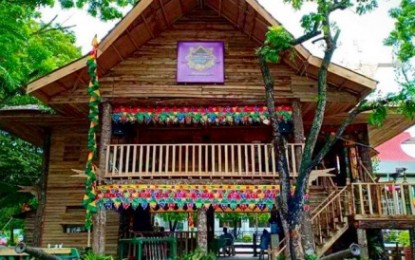
Maguindanao village replica at ARMM Villages Expo (Photo by BPI-ARMM)
COTABATO CITY--The Autonomous Region in Muslim Mindanao (ARMM) recently opened its grandest mock village exhibit that showcases the variety of cultures, traditions, history, and unity of the Bangsamoro people.
The display aims to give the public a glimpse of the Bangsamoro's rich cultural heritage and to bring lifelike presentations of unity amidst diversity of the culture of the region's people. Individuals, Moro and non-Moro alike, can also learn from, appreciate, and experience such cultural event.
The exhibit, located inside the Shariff Kabunsuan Complex, the provisional set of the ARMM in this city, features village replicas representing each of the ARMM’s five provinces namely: Maguindanao, Lanao del Sur, Basilan, Sulu, and Tawi-Tawi.
“The models of the villages were set up not just for mere appreciation, but for people to have a deep understanding of the various cultures of the region,” ARMM Governor Mujiv Hataman said.
Among the mock cultural villages in the exhibit is that of the province of Maguindanao, which literally means “flood plain”. Maguindanaon (people of the flood plain), as the people of the province are called, are among the many ethnic groups in the country.
A gigantic “Kampilan” welcomes visitors as they enter the Maguindanao village. The kampilan, or sword, is one of the well-preserved artifacts featured in the village.
Historical documents noted that the kampilan was widely used as weapon during warfare and as a headhunting sword. Built as the main attraction inside the Maguindanao village is a replica of Tulugan, or the House of Sultan, which symbolizes the government of the Maguindanaons.
In the early 15th century, Sharif Muhammad Kabunsuan from the Royal House of Malacca arrived in Mindanao and introduced the Islamic faith, custom, and the Sultanate system of governance.
Found inside the Tulugan is a set of the most important musical instruments of the Maguindanaon tribe–the Kulintang ensemble consisting of five instruments, namely the kulintang (a series of eight graduated gongs), agong (wide-rimmed gong), dabakan (goblet-shaped drum), gandingan (set of four thin-rimmed gongs), and the babandir (small thin-rimmed gong).
The Tulugan is adorned with colorful Maguindanaon traditional intertwines such as the Inaul, Tudung, and Galang (brassware). Also featured inside the Tulugan are Muslim brassware like the lutuan (silver-inlaid betel box), gadur (food containers with minaret-like tops), and panalagudan (pot holders).
These objects usually decorate the affluent Maguindanao home, indicating wealth and status. The rich culture of Maguindanao is just one of the many things the ARMM village expo offers.
Through the exhibit, people – especially those outside of the region – will get to experience what it is like to be part of a diverse yet united community that is the Bangsamoro. (Jho Kusain of Bureau of Public Information-ARMM)
